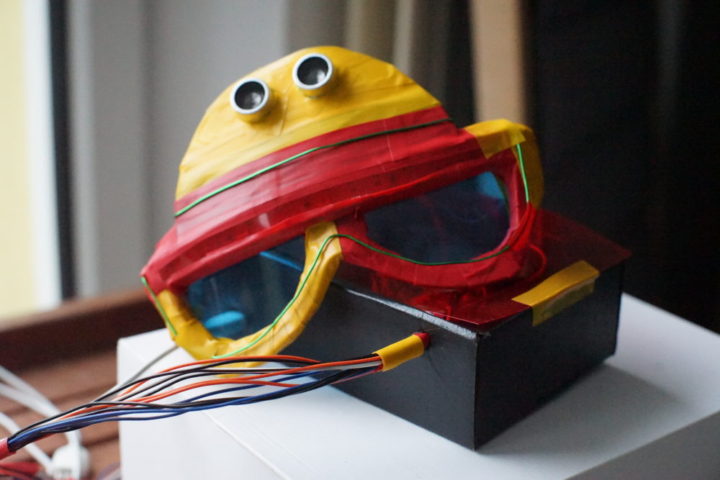Clint∞ns
Today, computers are ordinarily part of the spectrum of the common musical instruments present on stage. Inspired by the creativity, humour and craziness of funk musicians of Parliament and Funkadelic, as Georges Clinton, as well as the Afrofuturism movement (that explores the developing intersection of African/African Diaspora culture with technology), I thought it would be a great idea to build up a wearable MIDI interface as a physical computing artifact. Considering the stage as the performer’s habitat, how he senses and reacts to this environment, I decided to create goggles, aesthetically influenced by ritual masks and p-funk outfits. The device allows the artist to physically interact and improvise with a musical and performative “network”.
produced by: Raphael Theolade
On stage, the musician touches his instrument to produce sound. This sound is heard or listened by a crowd that shouts, claps, dances…What if the musician could also produce light to be seen by the crowd? What if the touch translates into sound and then translated into the light? What if the space around the musician, while focused on his performance and instrument are interfering with the sound? And what if the way he moves could also trigger sound events?
These questions led me to think of a way to link the actual musical instrument to the other elements on stage.
With this project, I wanted to explore the limits of the musical instrument and to show how they can be blurred with technology in a performative context. In this case, the architectural space, the body of the performer, the computer and the keyboard converge in the goggles. Their capability to communicate and interact, as a unique system, and their ability to link these elements together, transfer the musical specificity from a single item to a network of varied components gathered around the musician. Therefore, as a particular sensorial place of diverse interactions, I chose to consider the stage as a conceptual and metaphorical habitat.
When the musician is wearing the goggles and is playing or drawing notes in a clip in Ableton Live, MIDI notes on/off are sent to the Arduino. Each note triggers LEDs on the NeoPixel strip attached on the goggles. LED behaviour is modified by the distance to the surroundings red by the HC- SR04 sensor. If the musician shakes his head a tilt switch turns on and a sound clip can be played or an effect can be triggered.
I am already thinking of building a second version, based on everything I have learned from this project. In general, I think this device could be simpler and more efficient with a lighter design, better sensors like a gyroscope and complexified interactions with the environment (generative projections, mapping).
REFERENCES
- Banes.S & Lepecki. A. (2006) The Senses in Performance, Routledge; 1 edition
- Jones, J. (2018). [online] TRIOS : A Psychological Theory of the African Legacy in American Culture. Journal of Social Issues, Vol 59, No.1, 2003, pp 217-242, Rampages.us. Available at: https://rampages.us/soutsey/wp-content/uploads/sites/13104/2015/11/TRIOS.pdf [Accessed 16 Dec. 2018].
- Duke University Press. (2018). Afrofuturism. [online] Available at: https://www.dukeupress.edu/Afrofuturism/ [Accessed 16 Dec. 2018].
- Vice. (2018). Afrofuturism. [online] Available at: https://www.vice.com/sv/article/nnmgdx/afrofuturism [Accessed 16 Dec. 2018].
SOURCE CODE REFERENCES
https://github.com/arduino-libraries/MIDIUSB
https://github.com/adafruit/Adafruit_NeoPixel
https://www.arduino.cc/en/Main/Arduino_BoardLeonardo
































































